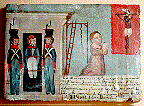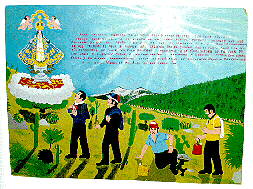|

 Retablos are Mexican folk paintings, usually created on small pieces of tin, offered as votives to images of Christ or the Virgin in thanks for a miracle granted or a favor received. Made by professional retablo artists, immigrant relatives or the immigrants themselves, the art works are posted on walls inside Catholic churches in Mexico, where they are public testament for all to behold. Three distinct parts generally comprise each retablo: the text describing the miracle; the scene where the miracle occurred; and the image of the deity, usually the Virgin Mary. In addition to their artistic interest, retablos are powerful sociological documents airing the subjects of greatest concern to the migrants: hazards of crossing the border; trials of finding work in an alien country; tribulations of working through legal problems; illness and accidents in a foreign land; the gratification -of achieving a small success; and the relief felt when migrants return home to their families. Retablos are Mexican folk paintings, usually created on small pieces of tin, offered as votives to images of Christ or the Virgin in thanks for a miracle granted or a favor received. Made by professional retablo artists, immigrant relatives or the immigrants themselves, the art works are posted on walls inside Catholic churches in Mexico, where they are public testament for all to behold. Three distinct parts generally comprise each retablo: the text describing the miracle; the scene where the miracle occurred; and the image of the deity, usually the Virgin Mary. In addition to their artistic interest, retablos are powerful sociological documents airing the subjects of greatest concern to the migrants: hazards of crossing the border; trials of finding work in an alien country; tribulations of working through legal problems; illness and accidents in a foreign land; the gratification -of achieving a small success; and the relief felt when migrants return home to their families.
 Originating from the Latin word retro-tabula, "behind the altar," retablos first referred to paintings and sculpture placed behind the altars of European Catholic churches in the early Middle Ages. Retablo painting gradually emerged as a genre in Mexico at the beginning of the seventeenth century as a unique fusion of European and Amerindian traditions. With the introduction of inexpensive tinplate in the mid-nineteenth century, many more people could afford to have retablos made. Today, retablos are a thriving popular art form that has influenced some of Mexico's leading artists. Originating from the Latin word retro-tabula, "behind the altar," retablos first referred to paintings and sculpture placed behind the altars of European Catholic churches in the early Middle Ages. Retablo painting gradually emerged as a genre in Mexico at the beginning of the seventeenth century as a unique fusion of European and Amerindian traditions. With the introduction of inexpensive tinplate in the mid-nineteenth century, many more people could afford to have retablos made. Today, retablos are a thriving popular art form that has influenced some of Mexico's leading artists.
 The retablo tradition is well known in Mexico, but not in the United States. Through the exhibit Miracles on the Border: Folk Paintings of Mexican Migrants to the U.S. the curators seek to introduce new audiences to this genre of art, while presenting a direct Mexican immigrant perspective on the complex process of migration. The retablo tradition is well known in Mexico, but not in the United States. Through the exhibit Miracles on the Border: Folk Paintings of Mexican Migrants to the U.S. the curators seek to introduce new audiences to this genre of art, while presenting a direct Mexican immigrant perspective on the complex process of migration.
|



